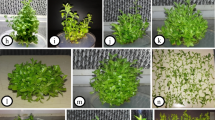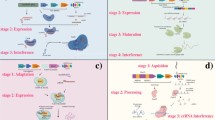Abstract
Production of transformed bitter gourd plants through in vitro regeneration is a laborious practice, which may also result in somaclonal variations. Thereby, in the current study, we have established a less tedious in planta protocol for more efficient genetic transformation of bitter gourd var. NBGH-470 (Apurva) using the seed as a target material. Bitter gourd seeds were transformed by Agrobacterium tumefaciens strain LBA4404 bearing the pCAMBIA1301 binary vector, and the transformed plants were selected against hygromycin B. The putatively transformed bitter gourd (To) plants were examined by GUS assay. Two parameters, including vacuum infiltration and sonication improving the in planta transformation, have been investigated in the present work. Amongst several time durations examined, the highest transformation rate (37%) was achieved upon subjecting the pre-cultured bitter gourd seeds to sonication for 15 min, followed by vacuum infiltration for 6 min in LBA4404 culture suspension. The transformed bitter gourd (T1) plants were selected against hygromycin B, and the transgene integration was evaluated by polymerase chain reaction (PCR), Southern hybridization, and reverse transcriptase PCR (RT-PCR). The developed protocol in the current study is suitable to genetically engineer the bitter gourd plants with disease and pest-resistant traits.





Similar content being viewed by others
References
Agarwal M, Kamal R (2004) In vitro clonal propagation of Momordica charantia L. Indian J Biotechnol 3(3):426–430
Al Munsur MAZ, Haque MS, Nasiruddin KM, Hossain MS (2009) In vitro propagation of bitter gourd (Momordica charantia L.) from nodal and root segments. Plant Tissue Cult Biotechnol 19(1):45–52
Arun M, Chinnathambi A, Subramanyam K, Karthik S, Sivanandhan G, Theboral J, Alharbi SA, Kim CK, Ganapathi A (2016) Involvement of exogenous polyamines enhances regeneration and Agrobacterium-mediated genetic transformation in half-seeds of soybean. 3 Biotech 6(2):148
Arun M, Subramanyam K, Mariashibu TS, Theboral J, Shivanandhan G, Manickavasagam M, Ganapathi A (2015) Application of sonication in combination with vacuum infiltration enhances the Agrobacterium-mediated genetic transformation in Indian soybean cultivars. Appl Biochem Biotechnol 175(4):2266–2287
Bakshi S, Sadhukhan A, Mishra S, Sahoo L (2011) Improved Agrobacterium-mediated transformation of cowpea via sonication and vacuum infiltration. Plant Cell Rep 30(12):2281–2292
Behera TK, Behera S, Bharathi LK, John KJ, Simon PW, Staub JE (2010) Bitter Gourd: Botany, Horticulture, Breeding. Hortic Rev (Am Soc Hortic Sci) 37:101–141
Beloin N, Gbeassor M, Akpagana K, Hudson J, De Soussa K, Koumaglo K, Arnason JT (2005) Ethnomedicinal uses of Momordica charantia (Cucurbitaceae) in Togo and relation to its phytochemistry and biological activity. J Ethnopharmacol 96(1-2):49–55
da Silva ML, Pinto DL, Passos AB, Marcelino-Guimarães FC, Rossi AA, Krause W, de Carvalho IF, Batista DS, Rocha DI, Otoni WC (2020) Novel and efficient transformation of wild passion fruit (Passiflora cincinnata Mast.) using sonication-assisted Agrobacterium-mediated transformation. In Vitro Cell Dev Biol Plant. https://doi.org/10.1007/s11627-020-10134-4
Dasgupta AA, Mukherjee AA, Mitra A (2009) Phyto-pharmacology of Momordica charantia linn. A review. J Glob Pharm Tech 3(3):7–14
Dellaporta SL, Wood J, Hicks JB (1983) A plant DNA minipreparation:version II. Plant Mol Biol Report 1(4):19–21
Feldmann KA, Marks MD (1987) Agrobacterium-mediated transformation of germinating seeds of Arabidopsis thaliana: a non-tissue culture approach. Mol Gen Genet 208(1):1–9
Grover JK, Yadav SP (2004) Pharmacological actions and potential uses of Momordica charantia: a review. J Ethnopharmacol 93(1):123–132
Gurusaravanan P, Vinoth S, Jayabalan N (2020) An improved Agrobacterium-mediated transformation method for cotton (Gossypium hirsutum L.‘KC3’) assisted by microinjection and sonication. In Vitro Cell Dev Biol Plant 56:111–121
Harrison SJ, Mott EK, Parsley K, Aspinall S, Gray JC, Cottage A (2006) A rapid and robust method of identifying transformed Arabidopsis thaliana seedlings following floral dip transformation. Plant Methods 2(1):19
Heiser CB (1979) The gourd book. University of Oklahoma Press, London
Hoekema A, Hirsch PR, Hooykaas PJ, Schilperoort RA (1983) A binary plant vector strategy based on separation of vir-and T-region of the Agrobacterium tumefaciens Ti-plasmid. Nature 303(5913):179–180
Islam R, Sarkar KP, Naderuzzaman ATM, Joarder OI (1994) In vitro regeneration of plants from cotyledons of Momordica charantia L. [in Bangladesh]. Plant Tissue Cult 4(2):105–109
Jaganath B, Subramanyam K, Mayavan S, Karthik S, Elayaraja D, Udayakumar R, Manickavasagam M, Ganapathi A (2014) An efficient in planta transformation of Jatropha curcas (L.) and multiplication of transformed plants through in vivo grafting. Protoplasma 251(3):591–601
Jefferson RA, Kavanagh TA, Bevan MW (1987) GUS fusions: β-glucuronidase as a sensitive and versatile gene fusion marker in higher plants. EMBO J 6(13):3901–3907
Karthik S, Pavan G, Sathish S, Siva R, Kumar PS, Manickavasagam M (2018) Genotype-independent and enhanced in planta Agrobacterium tumefaciens-mediated genetic transformation of peanut [Arachis hypogaea (L.)]. 3 Biotech 8(4):202
Khare CP (2008) Indian medicinal plants: an illustrated dictionary. Springer Science and Business Media.
Krishnan V, Jose J, Jolly M, Vinutha T, Kumar R, Manickavasagam M, Praveen S, Sachdev A (2020) ‘AGRODATE’: a rapid Agrobacterium-mediated transient expression tool for gene function analysis in leaf discs. J Plant Biochem Biotechnol 29(2):294–304
Kumar AM, Reddy KN, Sreevathsa R, Ganeshan G, Udayakumar M (2009) Towards crop improvement in bell pepper (Capsicum annuum L.):Transgenics (uid A:hpt II) by a tissue-culture-independent Agrobacterium-mediated in planta approach. Sci Hortic 119(4):362–370
Li S, Zhao DG, Wu YJ, Tian XE (2009) A simplified seed transformation method for obtaining transgenic Brassica napus plants. Agric Sci China 8(6):658–663
Malik S, Zia M, Chaudhary MF (2007) In vitro plant regeneration from direct and indirect organogenesis of Memordica charantia. Pak J Biol Sci 10(22):4118–4122
Manickavasagam M, Subramanyam K, Ishwarya R, Elayaraja D, Ganapathi A (2015) Assessment of factors influencing the tissue culture-independent Agrobacterium-mediated in planta genetic transformation of okra [Abelmoschus esculentus (L.) Moench]. Plant Cell Tissue Organ Cult 123(2):309–320
Mariashibu TS, Subramanyam K, Arun M, Mayavan S, Rajesh M, Theboral J, Manickavasagam M, Ganapathi A (2013) Vacuum infiltration enhances the Agrobacterium-mediated genetic transformation in Indian soybean cultivars. Acta Physiol Plant 35(1):41–54
Mayavan S, Subramanyam K, Arun M, Rajesh M, Dev GK, Sivanandhan G, Jaganath B, Manickavasagam M, Selvaraj N, Ganapathi A (2013) Agrobacterium tumefaciens-mediated in planta seed transformation strategy in sugarcane. Plant Cell Rep 32(10):1557–1574
Mayavan S, Subramanyam K, Jaganath B, Sathish D, Manickavasagam M, Ganapathi A (2015) Agrobacterium-mediated in planta genetic transformation of sugarcane setts. Plant Cell Rep 34(10):1835–1848
Murashige T, Skoog F (1962) A revised medium for rapid growth and bioassays with tobacco tissue cultures. Physiol Plant 15(3):473–497
Narra M, Kota S, Velivela Y, Ellendula R, Allini VR, Abbagani S (2018) Construction of chloroplast transformation vector and its functional evaluation in Momordica charantia L. 3. Biotech 8(3):140
National Horticultural Board-Area Production Statistics, (2020) http://www.nhb.gov.in Accessed 6 November 2020
Olhoft PM, Flagel LE, Donovan CM, Somers DA (2003) Efficient soybean transformation using hygromycin B selection in the cotyledonary-node method. Planta 216(5):723–735
Park BJ, Liu Z, Kanno A, Kameya T (2005) Transformation of radish (Raphanus sativus L.) via sonication and vacuum infiltration of germinated seeds with Agrobacterium harboring a group 3 LEA gene from B. napus. Plant Cell Rep 24(8):494–500
Raman A, Lau C (1996) Anti-diabetic properties and phytochemistry of Momordica charantia L. (Cucurbitaceae). Phytomedicine 2(4):349–362
Sambrook J, Russell DW (2001) Molecular cloning: A laboratory manual, the 3rd edition.
Shukla A, Singh VK, Bharadwaj DR, Kumar R, Rai A, Rai AK, Mugasimangalam R, Parameswaran S, Singh M, Naik PS (2015) De novo assembly of bitter gourd transcriptomes: gene expression and sequence variations in gynoecious and monoecious lines. PLoS One 10(6):e0128331
Sikdar B, Shafiullah M, Chowdhury AR, Sharmin N, Nahar S, Joarder OI (2005) Agrobacterium-mediated GUS expression in bitter gourd (Momordica charantia L.). Biotechnol 4(2):149–152
Song GQ, Walworth A, Hancock JF (2012) Factors influencing Agrobacterium-mediated transformation of switchgrass cultivars. Plant Cell Tissue Organ Cult 108(3):445–453
Subramanyam K, Arunachalam C, Thaneswari RM, Sulaiman AA, Manickavasagam M, Ganapathi A (2015) Highly efficient Agrobacterium-mediated in planta genetic transformation of snake gourd (Tricosanthes cucumerina L.). Plant Cell Tissue Organ Cult 123(1):133–142
Subramanyam K, Rajesh M, Jaganath B, Vasuki A, Theboral J, Elayaraja D, Karthik S, Manickavasagam M, Ganapathi A (2013) Assessment of factors influencing the Agrobacterium-mediated in planta seed transformation of brinjal (Solanum melongena L.). Appl Biochem Biotechnol 171(2):450–468
Sujatha M, Sailaja M (2005) Stable genetic transformation of castor (Ricinus communis L.) via Agrobacterium tumefaciens-mediated gene transfer using embryo axes from mature seeds. Plant Cell Rep 23(12):803–810
Supartana P, Shimizu T, Nogawa M, Shioiri H, Nakajima T, Haramoto N, Nozue M, Kojima M (2006) Development of simple and efficient in planta transformation method for wheat (Triticum aestivum L.) using Agrobacterium tumefaciens. J Biosci Bioeng 102(3):162–170
Supartana P, Shimizu T, Shioiri H, Nogawa M, Nozue M, Kojima M (2005) Development of simple and efficient in planta transformation method for rice (Oryza sativa L.) using Agrobacterium tumefaciens. J Biosci Bioeng 100(4):391–397
Thiruvengadam M, Mohamed SV, Yang CH, Jayabalan N (2006) Development of an embryogenic suspension culture of bitter melon (Momordica charantia L.). Sci Hortic 109(2):123–129
Thiruvengadam M, Praveen N, Chung IM (2012) An efficient Agrobacterium tumefaciens-mediated genetic transformation of bitter melon (Momordica charantia L.). Aust J Crop Sci 6(6):1094–1100
Wang L, Waltenberger B, Pferschy-Wenzig EM, Blunder M, Liu X, Malainer C, Blazevic T, Schwaiger S, Rollinger JM, Heiss EH, Schuster D (2014) Natural product agonists of peroxisome proliferator-activated receptor gamma (PPARγ): a review. Biochem Pharmacol 92(1):73–89
Wang S, Tang L, Chen F (2001) In vitro flowering of bitter melon. Plant Cell Rep 20(5):393–397
Welihinda J, Karunanayake EH, Sheriff MH, Jayasinghe KS (1986) Effect of Momordica charantia on the glucose tolerance in maturity onset diabetes. J Ethnopharmacol 17(3):277–282
Yashodhara V, Muralikrishna N, Raghu E, Bharathkumar K, Rathnaprabha D, Sadanandam A (2016) In vitro plant regeneration from petiole explants and assessment of genetic fidelity using ISSR markers in Momordica charantia L. PCBMB 17(1&2):49–56
Yellisetty V, Reddy LA, Mandapaka M (2015) In planta transformation of sorghum (Sorghum bicolor (L.) Moench) using TPS1 gene for enhancing tolerance to abiotic stresses. J Genet 94(3):425–434
Zafar R, Neerja (1991) Momordica charantia-a review. Hamdard Med 34:49–61
Zale JM, Agarwal S, Loar S, Steber CM (2009) Evidence for stable transformation of wheat by floral dip in Agrobacterium tumefaciens. Plant Cell Rep 28(6):903–913
Acknowledgements
Dr. Sivabalan Karthik acknowledges Jawaharlal Nehru Memorial Fund, New Delhi, India, for the grant of Jawaharlal Nehru Scholarship (Ref no: SU-1/88/2016-17/79) to conduct the present work. The authors also acknowledge RUSA, 2.0-Biological Sciences, Bharathidasan University, Tiruchirappalli, Tamil Nadu, India, for providing financial support.
Author information
Authors and Affiliations
Corresponding author
Ethics declarations
Conflict of interest
The authors declare no competing interests.
Additional information
Editor: Yong Eui Choi
Rights and permissions
About this article
Cite this article
Karthik, S., Pavan, G., Prasanth, A. et al. Improved in planta genetic transformation efficiency in bitter gourd (Momordica charantia L.). In Vitro Cell.Dev.Biol.-Plant 57, 190–201 (2021). https://doi.org/10.1007/s11627-021-10160-w
Received:
Accepted:
Published:
Issue Date:
DOI: https://doi.org/10.1007/s11627-021-10160-w




